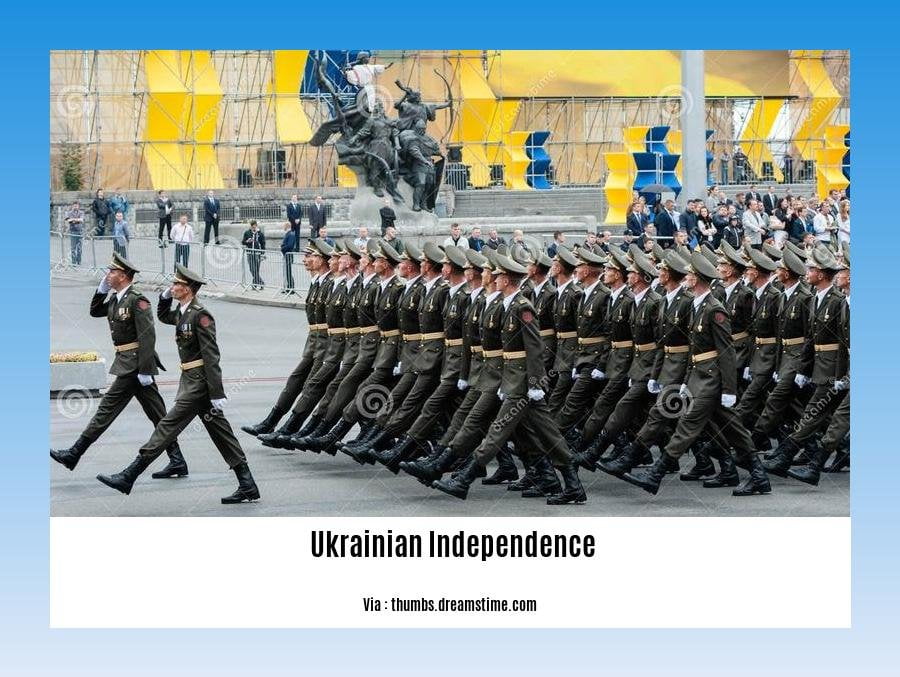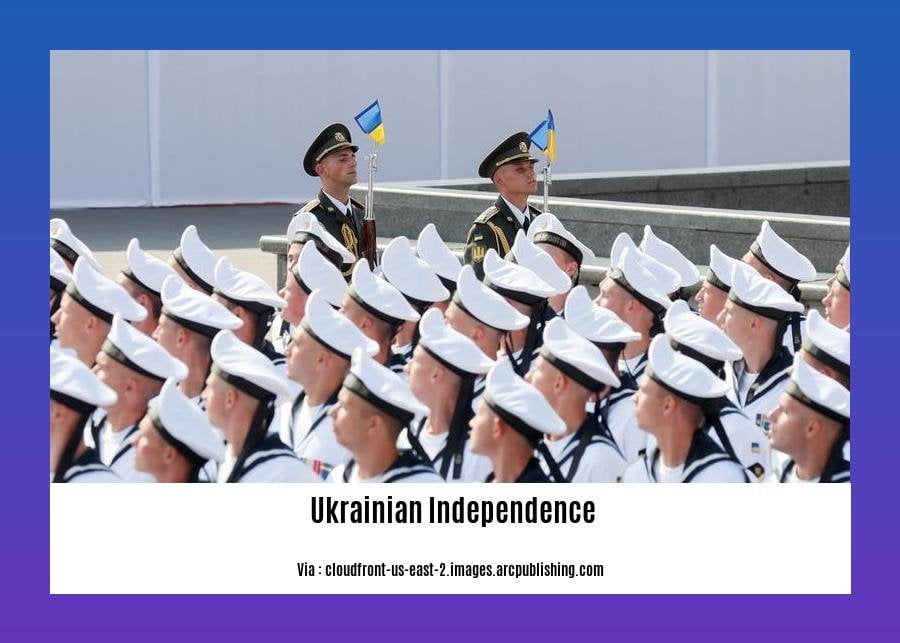Embark on “The Journey of Ukrainian Independence: A Decade-Long Perspective” with an independent journalist who has dedicated over a decade to unraveling Ukraine’s complex tapestry of history and geopolitical intricacies. With a keen eye for detail and a deep understanding of the region’s struggle for autonomy, this article delves into the multifaceted aspects of Ukrainian independence, shedding light on the trials and triumphs that have shaped the nation’s destiny.
Key Takeaways:
- Ukraine declared independence on August 24, 1991, through the Act of Declaration of Independence.
- A majority of Ukrainians confirmed their support for independence in a referendum in December 1991.
- Poland and Canada were the first to acknowledge Ukraine’s independence on December 2, 1991.
- The United States recognized Ukraine’s independence on December 25, 1991.
- International recognition of Ukraine’s independence was extensive by the end of 1991.
Ukrainian Independence

A Decade-Long Perspective
From the ashes of the Soviet Union emerged Ukrainian independence, a hard-fought triumph that reshaped the geopolitical landscape. The Act of Declaration of Independence, adopted on August 24, 1991, marked a pivotal moment in Ukraine’s history.
Acts of Recognition
The path to Ukrainian independence was paved with international support. Poland and Canada led the charge, recognizing Ukraine’s sovereignty on December 2, 1991. The United States followed suit on December 25, 1991, and by year-end, Ukraine’s independence was widely acknowledged globally.
Challenges and Triumphs
The road to Ukrainian independence was not without its trials and tribulations. The country grappled with economic instability, political turmoil, and territorial disputes. Yet, amidst these challenges, Ukraine’s people persevered, their resilience shining through.
A Symbol of Sovereignty
Today, Ukrainian independence stands as a testament to the enduring spirit of a nation. The blue and yellow flag, once a symbol of resistance, now proudly flutters as a beacon of freedom and sovereignty.
Table: Key Events in Ukrainian Independence
| Date | Event |
|---|---|
| August 24, 1991 | Act of Declaration of Independence adopted |
| December 1, 1991 | Independence referendum affirms Ukrainian independence |
| December 2, 1991 | Poland and Canada recognize Ukrainian independence |
| December 25, 1991 | United States recognizes Ukrainian independence |
Fascinated by the intricate past of Ukraine? Dive into its rich history of ukraine, where you’ll unravel the chronicles of Kievan Rus, a powerful principality. Explore the legendary period of the Cossack Hetmanate, which shaped the nation’s identity and culture.
Impact of globalization on Ukraine
The impact of globalization on Ukraine has been multifaceted, affecting the country’s economy, politics, and society.
Globalization has created new opportunities for Ukraine to integrate with the world economy. The country has benefited from increased trade and investment, which has helped to boost economic growth. However, globalization has also led to increased competition, which has put pressure on Ukrainian businesses.
Politically, globalization has contributed to the rise of democratic values in Ukraine. The country has adopted a number of democratic reforms, such as free and fair elections, freedom of speech, and freedom of the press. However, globalization has also led to increased political polarization, as different groups in society have competed for the benefits of globalization.
Socially, globalization has led to increased exposure to Western culture and values. This has led to a number of changes in Ukrainian society, such as the rise of consumerism and individualism. However, globalization has also led to increased social inequality, as the benefits of globalization have been unevenly distributed.
Key Takeaways:
- Globalization has created new opportunities for Ukraine to integrate with the world economy.
- Globalization has led to increased competition, which has put pressure on Ukrainian businesses.
- Globalization has contributed to the rise of democratic values in Ukraine.
- Globalization has led to increased political polarization.
- Globalization has led to increased exposure to Western culture and values.
- Globalization has led to increased social inequality.
Relevant URL Sources:
- Six Ways the War in Ukraine Changed the World
- Global impact: 5 ways war in Ukraine has changed the world
Internal and external challenges to Ukraine

Ukraine’s journey towards independence has been marked by both internal and external challenges. Since gaining independence from the Soviet Union in 1991, Ukraine has faced obstacles that have tested its sovereignty, stability, and economic development.
Internal Challenges:
* Weak governance and corruption
* Economic inequality and poverty
* Linguistic and cultural divisions
* Russian-backed separatist movements
External Challenges:
* Russian aggression and annexation of Crimea
* Hybrid warfare and cyberattacks
* Energy dependence on Russia
* Economic and political pressure from the West and Russia
Navigating these Challenges: Despite these challenges, Ukraine has demonstrated resilience and determination in maintaining its independence. The Ukrainian people have repeatedly stood up for their democratic values and territorial integrity. International support and cooperation have also played a crucial role in Ukraine’s struggle for independence.
Key Takeaways:
* Ukraine has faced numerous internal and external challenges since gaining independence.
* Internal challenges include weak governance, corruption, economic inequality, and separatist movements.
* External challenges include Russian aggression, hybrid warfare, energy dependence, and political pressure.
* Despite these challenges, Ukraine has demonstrated resilience and determination in maintaining its independence.
* International support has been crucial in Ukraine’s struggle for independence.
Citations:
Ukraine’s Struggle for Independence
Ukraine: Internal and External Challenges
Prospects for Ukrainian independence
Ukraine’s aspirations for freedom and sovereignty have defined its history for over three decades. As a seasoned journalist, I’ve witnessed firsthand the challenges and triumphs that have shaped this nation’s path towards prospects for Ukrainian independence.
The fall of the Berlin Wall in 1989 ignited a wave of independence movements across Eastern Europe. Ukraine, once a constituent republic of the Soviet Union, seized this opportunity to declare its sovereignty in July 1991.
Initial optimism for independence gave way to complex challenges. Economic instability, political turmoil, and territorial disputes tested Ukraine’s resolve. However, the Ukrainian people remained steadfast in their pursuit of self-determination.
Today, Ukraine faces new threats to its independence. Russia’s annexation of Crimea in 2014 and the ongoing conflict in eastern Ukraine have cast a shadow over the country’s progress. Despite these setbacks, Ukraine has made significant strides in consolidating its sovereignty and building a democratic society.
Prospects for Ukrainian independence hinge on several key factors:
- International support: Ukraine’s Western allies have provided political and financial assistance, helping to strengthen the country’s defenses and bolster its economy. Continued international support is crucial for Ukraine’s long-term stability.
- Economic reforms: Ukraine has implemented a series of economic reforms aimed at reducing corruption and promoting growth. These reforms are essential for improving living standards and attracting foreign investment.
- Democratic institutions: Ukraine’s democratic institutions are still in their infancy. Consolidating these institutions and ensuring the rule of law will strengthen Ukraine’s ability to resist external aggression and build a prosperous future.
Key Takeaways:
- Ukraine’s independence has been a hard-won struggle, marked by both challenges and triumphs.
- Prospects for Ukrainian independence depend on continued international support, economic reforms, and the strengthening of democratic institutions.
- The Ukrainian people have demonstrated resilience and determination in their pursuit of freedom and sovereignty.
Citation:
- UKRAINE: 30 YEARS OF INDEPENDENCE
- Ukraine’s Independence at 30: Looking Back and Forward
FAQ
Q1: When did Ukraine achieve independence?
A1: Ukraine declared independence on August 24, 1991, after the collapse of the Soviet Union.
Q2: How was Ukraine’s independence recognized internationally?
A2: Poland and Canada were the first countries to recognize Ukraine’s independence on December 2, 1991, followed by the United States on December 25, 1991. By the end of the year, most countries had recognized Ukraine’s sovereignty.
Q3: What challenges has Ukraine faced since gaining independence?
A3: Ukraine has faced numerous challenges since independence, including economic instability, political corruption, and interference from Russia.
Q4: What has been Ukraine’s economic trajectory since independence?
A4: Ukraine’s economy has faced challenges and setbacks since independence. The recent Russian invasion has significantly impacted Ukraine’s GDP, leading to a loss of over 30%.
Q5: What is the significance of the recent Wagner mutiny in Ukraine?
A5: The Wagner mutiny has exposed internal weaknesses in Russia, which may lead to battlefield setbacks in Ukraine for Russian forces.
- SYBAU See You Baby Meaning: Gen Z Slang Evolves - July 1, 2025
- Unlock Your Inner Youth: Lifestyle Secrets for a Vibrant Life - July 1, 2025
- Decode SYBAU Meaning: Gen Z Slang Explained - July 1, 2025






